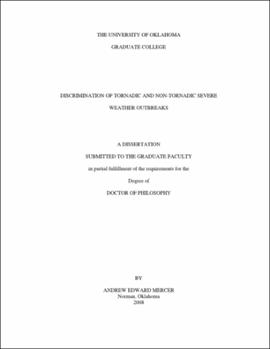| dc.contributor.advisor | Richman, Michael B | |
| dc.creator | Mercer, Andrew Edward | |
| dc.date.accessioned | 2019-04-27T21:38:49Z | |
| dc.date.available | 2019-04-27T21:38:49Z | |
| dc.date.issued | 2008 | |
| dc.identifier | 9947198702042 | |
| dc.identifier.uri | https://hdl.handle.net/11244/319252 | |
| dc.description.abstract | Outbreaks of severe weather affect the majority of the conterminous United States. An outbreak is characterized by multiple severe weather occurrences within a single synoptic system. Outbreaks can be categorized by whether or not they produce tornadoes. It is hypothesized that the antecedent synoptic signal contains important information about outbreak type. Accordingly, the scope of this research is to determine the extent that the synoptic signal can be utilized to classify outbreak type at various lead times. | |
| dc.description.abstract | Outbreak types are classified using the NCEP/NCAR reanalysis data, which are arranged on a global 2.5º latitude-longitude grid, include 17 vertical pressure levels, and span from 1948 to the present (2008). Fifty major tornado outbreak (TO) cases and fifty major non-tornadic severe weather outbreak (NTO) cases are selected for this work. Two types of analyses are performed on these cases to assess discrimination ability. One analysis involves outbreak classification using the Weather Research and Forecasting (WRF) model initialized with the NCEP/NCAR reanalysis dataset. Meteorological covariates are computed from the WRF output and used in training and testing of statistical classification models. The covariate fields are depicted on a 21 X 21 gridpoint field with an 18 km grid spacing centered on the outbreak. Covariates with large discrimination potential are determined using permutation testing. A P-mode principal component analysis (PCA) is used on the subset of covariates determined by permutation testing to reduce data dimensionality, since numerous redundancies exist in the initial covariate set. Three statistical classification models are trained and tested with the resulting PC scores: a support vector machine (SVM), a logistic regression model (LogR), and a multiple linear regression model (LR). Promising results emerge from these methods, as a probability of detection (POD) of 0.89 and a false alarm ratio (FAR) of 0.13 are obtained from the best discriminating statistical technique (SVM) at 24-hours lead time. Results degrade only slightly by 72-hours lead time (maximum POD of 0.833 and minimum FAR of 0.276). | |
| dc.description.abstract | Synoptic composites of the outbreak types are the second analysis considered. Composites are used to reveal synoptic features of outbreak types, which can be utilized to diagnose the differences between classes (in this case, TOs and NTOs). The composites are created using PCA. Five raw variables, height, temperature, relative humidity, and u and v wind components, are extracted from the NCEP/NCAR reanalysis data for North America. Converging longitude lines with increasing latitude on the reanalysis grid introduce bias into correlation calculations in higher latitudes; hence, the data are mapped onto both a latitudinal density grid and a Fibonacci grid. The resulting PCA produces two significant principal components (PCs), and a cluster analysis on these PCs for each outbreak type results in two types of TOs and NTOs. TO composites are characterized by a trough of low pressure over the central United States and major quasigeostrophic forcing features such as an upper level jet streak, cyclonic vorticity advection increasing with height, and warm air advection. These dynamics result in a strong surface cyclone in most tornado outbreaks. These features are considerably less pronounced in NTOs. The statistical analyses presented herein were successful in classifying outbreak types at various lead times, using synoptic scale data as input. | |
| dc.format.extent | 160 pages | |
| dc.format.medium | application.pdf | |
| dc.language | en_US | |
| dc.relation.requires | Adobe Acrobat Reader | |
| dc.subject | Severe storms | |
| dc.subject | Tornadoes | |
| dc.subject | Synoptic meteorology | |
| dc.subject | Weather forecasting--Mathematical models | |
| dc.title | Discrimination of Tornadic and Non-Tornadic Severe Weather Outbreaks | |
| dc.type | text | |
| dc.type | document | |
| dc.thesis.degree | Ph.D. | |
| ou.group | College of Atmospheric & Geographic Sciences::School of Meteorology | |
